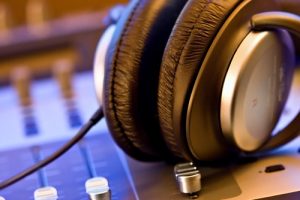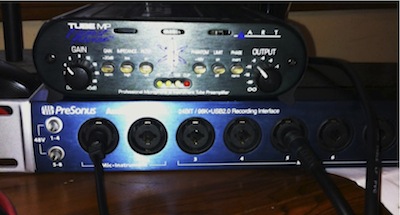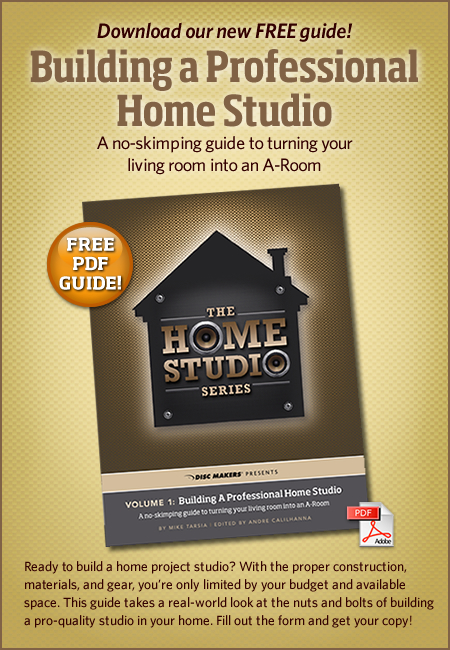 [This article was written by guest contributor Pat Walsh, lead guitarist of the band Chaser Eight.]
[This article was written by guest contributor Pat Walsh, lead guitarist of the band Chaser Eight.]
As most of us are well aware, we’re now living in the age of the home recording studio. An old laptop with some inexpensive gear can now produce high fidelity recordings that can rival those made in expensive studios. Still, many musicians who aren’t engineers (me included) can find the task of recording and producing a great track a little daunting. Through a lot of trial and error I have learned a few things over the years while producing tracks for my band, Chaser Eight. Here are 5 tips that home recording enthusiasts can employ right now to start getting more polished recordings.
1. Get a Preamp
Plugging a guitar or microphone directly into your recording interface can often produce a very transparent sound that lacks the warmth and volume that a great track requires. There is an easy and inexpensive way to get a better source sound: plug the guitar or microphone into a preamp first.
A decent preamp one can be obtained for as little as $50 and will immediately add volume and warmth to everything that you record. A few technical things to note: First, if you buy a tube preamp, it’s best to junk the tube that comes with it and replace it with a better one (doing so requires nothing more than a screwdriver) which you can buy at a guitar shop.
Secondly, keep in mind that the output of the preamp will require a balanced audio cable such as a TSR or XLR cable. Don’t try and connect the preamp to your interface with just an instrument cable, even though it will fit into the input.


First plug your guitar or microphone into a Preamp, like The Tube MP pictured above, rather than directly into the Interface for improved sound quality.
2. Dive In And Constantly Use the Web As a Resource
I notice that friends that are new to this will buy large books about home recording before they start actually trying to do any real recording themselves. These tomes can be solid resources, but for the most part, I think it’s best to bypass them at first and just dive right in. Trial and error is the best teacher.
Most contemporary recording software programs, like GarageBand, are very user friendly and don’t require a lot of time to learn at a basic level. Just start experimenting, and develop your own base knowledge. Once you’ve done this experimentation, then it’s time to use the web to learn specific tasks. The two best sources of information are YouTube and a site called GearSlutz. They each provide oceans of tutorials and advice on virtually every topic with respect to recording. Maybe you’ve learned how to record drums fairly well on your own, but you are not sure how to properly EQ a snare drum. Go look it up. Maybe you have recorded a good vocal track but you’d like to know a little bit more about using pitch correction effectively? Seek and you shall find. I continue to learn new methods this approach.
Again, don’t try and take in all of this information at once. It will overwhelm you and make the task of engineering great tracks seem impossible. Advanced books and the like are actually more useful after you’ve gotten a lot of hours under your belt, not before.
3. Invest in One Good Large Diaphragm Condenser Microphone
This isn’t earth-shattering news to most home recording enthusiasts, but I can’t overstate its importance: it is imperative to buy a good condenser microphone.
I strongly recommend that anyone mastering their own recordings, even on a shoestring budget, make purchasing a large diaphragm condenser microphone mandatory. The reason I believe in this item so dearly is that in addition to recording vocals, you can also record acoustic instruments (acoustic guitars, mandolins, banjos, etc.), light percussion (tambourines, bongos, etc.), and a whole host of other things.
I also love to use mine as a room microphone when recording drums. If you start buying separate condenser microphones of various shapes and sizes for all of these different tasks then your wallet is going to take a beating, and the results really won’t change all that much. I’m a fan of the Rode NT1A, but if you want to stay under $200 there are plenty of excellent options out there.


This Rode NT1A, a large diaphragm microphone, can be used to record many things besides vocals.
4. Invest In Some Good Mastering Software
One thing that virtually any new home recording enthusiast inevitably says is, “my track is done, but it’s not as loud or punchy as my favorite band’s tunes are.”
Many folks will then turn to professional engineers to master their finished songs. While these consultants often do great work (at increasingly cheap rates), it is no longer required that artists use them. If you are like me and like to record a lot of material, using a lot of outside engineer help is just too expensive.
Nowadays, mastering software is inexpensive, user-friendly, and very effective. I use a product called Ozone by Izotope. You can get it for about $200, and older versions of the product can be had for even less. Other options exist as well, and none of them take very much time to learn. The components of the software, like the Reverb or Compression units, can be used on individual tracks within the recording as well, so these products have many, many uses beyond just mastering the final tune. Of course, professional engineers are going to be better (I don’t think Coldplay is going to decide to start mastering their tracks using $200 software), but you will definitely be very happy with the results you get, and they will be on-par with what you hear professionally mastered.
5. Get Decent Monitors, You Don’t Need Great Ones
Some home recording enthusiasts fall into the trap of buying excessively expensive monitors for playback. If you happen to be a Rockefeller or a Hilton and can shell out $7,000 for massive monitors with an obscenely powerful subwoofer I’m all for it (and please, let’s be friends). But if you are on a budget like me, nothing fancy is required.
My inexpensive M-Audio AV40 speakers, with no subwoofer to speak of, get the job done just fine. The only important thing is to simply know the characteristics of your monitors compared to other speakers. Listen to your tracks (as well as commercial recordings) on headphones, car stereos, and cheap computer speakers and compare what you hear to the sound profile of your monitors. Maybe your monitors don’t project certain frequencies especially well so you know to turn those up a little bit when mixing. It is really no more complicated than that. If you follow this rule your tracks will be just as well mixed as the guy or gal who is using an exceptionally expensive monitoring system.


My democracy loving M-Audio Monitors get the job done at a low cost.
If you would like to hear these techniques in action, check out my band’s music at either of these locations:
For more tips on home recording, check out Disc Makers’ FREE guide:
[Headphone image from Shutterstock.]
